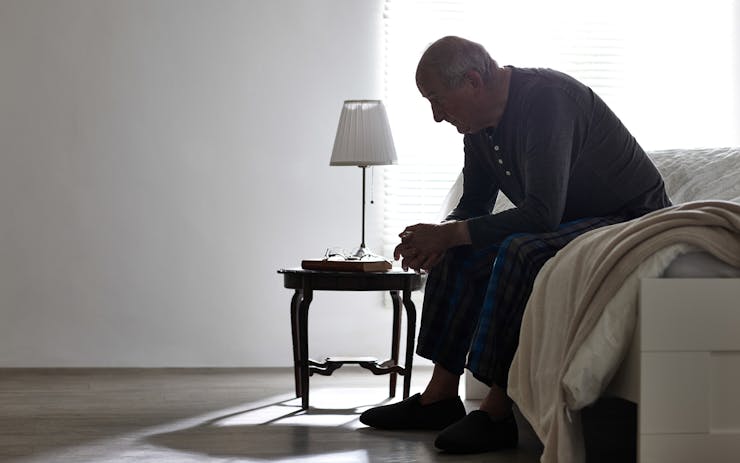My dad spent the last two years of his life in a skilled nursing facility. He’d complain about the nightly noise—the screams, shrieks and cries of dementia patients—that made sleeping difficult.
I made hashish biscuits and offered them to my elderly father around dinnertime. The next day I asked how he slept. 'Gooooood,' he said.
My dad liked biscuits. I like cannabis. One day I made hashish biscuits and delivered them to my dad around dinner time. I returned the next day and asked my dad how he slept.
“I slept goooooooood,” he said.
I told my dad I’d dosed him. An old Mexican who sold opium to village elders as a boy, he knew the curative powers as well as the political and cultural propaganda surrounding marijuana. But he asked me not to make these biscuits again, fearing he’d be kicked out of the home if the administration found out. He returned to sleepless nights.
A real alternative for seniors
Insomnia is a nagging affliction for many people who suffer conditions such as anxiety, chronic pain, PTSD, depression and restless leg syndrome. Cannabis, according to doctors, nurses and caregivers who work with seniors, is an effective treatment for elderly people and others who suffer from insomnia.
In this week’s episode of “Eyes Wide Open,” the Zana/Leafly podcast about cannabis and insomnia, hosts Jeremy Kossen and Seth Lorinczi explore many issues specific to seniors and insomnia. You can hear the full episode here:
Listen to “Zana HealthLab” on Spreaker.
As part of our focus on seniors and insomnia this week, we sought out stories and perspectives from four people in the San Francisco Bay Area—a dispensary owner, a nurse, a doctor and a retired political aide—who use and endorse cannabis to treat insomnia.
Seniors rarely sleep through the night
Sue Taylor is a former Catholic school principal turned expert on senior citizens and cannabis. Licensed by the state of California to educate doctors and nurses on the use of cannabis as medicine, she also serves as a county commissioner on aging. Taylor is working to open a cannabis dispensary in Berkeley this summer aimed at specifically serving senior citizens.
In a recent interview with Leafly, Taylor said insomnia is a common ailment among the seniors she meets at the educational events she conducts at senior communities and care facilities.
“You rarely find a senior who can sleep through the night, including myself,” said Taylor, 69. “It’s a major concern. A lot of seniors use alcohol to put them to sleep. We’ve got to get the word out that there are healthier ways to help them sleep.”
Taylor didn’t use cannabis until she started working with seniors as an outreach coordinator at pioneering Oakland medical cannabis dispensary Harborside Health Center seven years ago. Nowadays she uses small doses of a tincture that’s high in CBD, a non-intoxicating cannabinoid, and low in THC, the primary psychoactive compound in cannabis. It’s a 30:1 ratio of CBD to THC.
“I don’t want anything foreign in my body,” Taylor said. “I don’t take a pill for anything. My doctor told me to use Benadryl to sleep. The pharmaceutical approach to health care in our country—all these opiates and other pills—that has to be addressed. Cannabis can eliminate all of that.”
Taylor sees herself as a cannabis ambassador whose job is to remove the stigma of the botanical drug for a generation that was raised on “Reefer Madness.” The audiences she works with like to adhere to rules, and at the same time they’re overwhelmed by prescription drugs.
“Life is not a bitch and then you die when you’re 50,” Taylor said. “You can live a thriving, useful life as you age. But you can’t do it if you’re on 15 pills. That robs you of the happiness that you deserve. Cannabis can help people in our age group live better lives.”
The no-narco nurse
Barbara Blaser, 71, is a registered nurse who consults with patients at Magnolia Wellness, an Oakland medical cannabis dispensary run by her daughter Debby Goldsberry, a long-time cannabis activist.
While she can’t legally recommend cannabis products, Blaser steers Magnolia’s patients toward the treatments she herself uses for her own anxiety-induced insomnia—a 5-mg dose of 18:1 CBD-THC tincture and 5 mgs of an edible. The tincture takes effect within a few minutes. The edible takes in about 90 minutes, just as the tincture wears off and she’s falling asleep.
'It was difficult to recognize that cannabis wasn't going to hurt me, that my mother wasn't going to be in my dreams screaming at me.'
“I wear a Fitbit activity tracker and the Fitbit logs your sleep,” Blaser said. “I can see from the time I took my tincture to the time I went to sleep and as the edible puts me at a different level of sleep, lasting about 5 to 7 hours.”
Blaser said about 40 percent of the patients she meets at Magnolia suffer from insomnia.
“There’s a whole lot out there that’s gonna make a difference for seniors,” she told Leafly, “because not sleeping can really put a dent in your life.”
Blaser discovered cannabis’ benefits later in life.
“It took me a long time to decide to use cannabis because I grew up with Nancy Reagan and ‘Just Say No,’” Blaser said. “It was difficult to recognize that cannabis wasn’t going to hurt me, that my mother wasn’t going to be in my dreams screaming at me.”
Blaser said her husband also noticed the benefits of cannabis.
“I actually stopped taking it for a little while and my husband, about three days later, said, ‘Do you think you can go back on that?’ I was restless.”
Half of her patients have insomnia
Dr. Vanessa Niles, 61, discovered the medical benefits of cannabis several years ago when a colleague was diagnosed with breast cancer and asked Niles to treat her with cannabis.
“I lived in Georgia and we had to go through a lot to get cannabis to relieve her symptoms,” Niles said. “That’s why I’m here” in California.
Today, Niles operates a medical cannabis evaluation clinic in Vallejo, northeast of San Francisco.
“We see approximately 40 patients a day and half of them have insomnia,” Niles said. “It doesn’t matter what the original disease issue was. It can be related to pain, post-traumatic stress disorder, anxiety, depression, restless leg syndrome, cancer. It ends up in insomnia.”
She said about one-third of her patients are senior citizens.
“You’d be surprised at how millennials and people in their 40s and 50s suffer from insomnia,” Niles said.
Niles said she recommends edibles and indica strains. She herself uses cannabis to treat her own sleep issues.
“I take a tincture that’s a combination CBD and THC, a 1:1 ratio,” she said. “In addition to that I take an edible that’s about 25 to 50 mg.”
She said she longs for the day when doctors in the United States can conduct the progressive cannabis research that’s taking place in Israel, Canada and the UK.
“We need to get cannabis off of Schedule 1 and get down to the real science behind it,” Niles said. “Clearly, we have proven that patients get great relief from cannabis. But until we get it off being a Schedule 1 drug, we are in a quandary.”
Midnight toker
Bob, a suburban East Bay retiree who asked that his last name not be used because, he said, “Jeff Sessions,” vaporizes hybrid strains of cannabis flowers and smokes hashish to help him sleep.
“I’ve got prostate issues that make me get up in the middle of the night three or four times to go to the bathroom,” he said. “I get the first three hours of sleep pretty good and then I have to get up to go the bathroom. But if there’s something cooking on my mind or if Donald Trump gets into my head, I can’t get back to sleep. So what I do is take a couple hits of cannabis and get back to sleep.”
As someone who’s used cannabis “off and on since 1965,” Bob, 71, said his nightly routine includes cannabis to help him relax before bed and to alleviate arthritis pain in his hips.
He said he suffers no intoxicating effects that make him fear falling or leave him feeling hungover in the morning.
“That’s the nice thing about it,” he said. “If I take some of these pharmaceutical sleep aids or codeine, the next day I’m shot and dopey until noon.”
A former aide to a pro-cannabis politician, Bob said there needs to be more education about how cannabis benefits seniors.
“My wife and I took care of a cancer patient in 2000,” Bob said. “The hospice said he was going to die within 48 hours. We gave him some cannabis in a pipe and about 20 minutes later he said, ‘Maybe I will eat.’ He was down to 93 pounds. He started eating and he lived for another year.”







